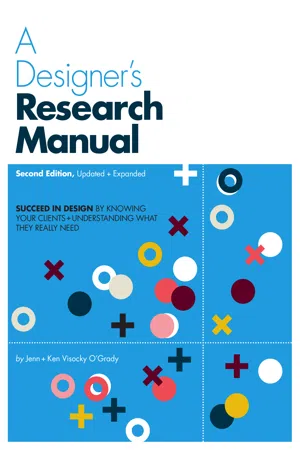
A Designer's Research Manual, 2nd edition, Updated and Expanded
Succeed in Design by Knowing Your Clients and Understanding What They Really Need
- 208 pages
- English
- ePUB (mobile friendly)
- Available on iOS & Android
A Designer's Research Manual, 2nd edition, Updated and Expanded
Succeed in Design by Knowing Your Clients and Understanding What They Really Need
About this book
Good information gives designers a competitive advantage. Understanding the wishes of a client and the needs and preferences of their audience drives innovation. The ability to gather research, analyze findings, and apply them to project goals is as important to successful design teams as their conceptual and aesthetic skills. This essential handbook will help readers understand what design research is and why it is necessary, outline proven techniques and methods, and explain how to incorporate them into any creative process.
A Designer’s Research Manual was one of the first books to apply research practices to the benefit of visual communication designers. This long awaited second edition follows more than a decade of active use by practitioners, design educators, and students around the world. Comprehensively updated, A Designer's Research Manual second edition includes:
- Over 25 proven research strategies and tactics
- Added content about planning research, analyzing results, and integrating research into the design process
- Suggestions for scaling research for any project, timeline, or budget
- All new in-depth case studies from industry leaders, outlining strategy and impact
- Updated images, illustrations, and visualizations
- Quick Tips for rapid integration of research concepts into your practice
Frequently asked questions
- Essential is ideal for learners and professionals who enjoy exploring a wide range of subjects. Access the Essential Library with 800,000+ trusted titles and best-sellers across business, personal growth, and the humanities. Includes unlimited reading time and Standard Read Aloud voice.
- Complete: Perfect for advanced learners and researchers needing full, unrestricted access. Unlock 1.4M+ books across hundreds of subjects, including academic and specialized titles. The Complete Plan also includes advanced features like Premium Read Aloud and Research Assistant.
Please note we cannot support devices running on iOS 13 and Android 7 or earlier. Learn more about using the app.
Information
CHAPTER 1
WHAT IS
RESEARCH-DRIVEN
DESIGN?

WHAT RESEARCH CAN
AND CAN‘T DO

Table of contents
- Cover
- Title Page
- Contents
- Introduction: Why This Book?
- Chapter 1: An Overview of Research in Graphic Design
- Chapter 2: Research Strategies+Tactics
- Chapter 3: Practicing a Research-Driven Approach
- Chapter 4: Project Spotlights
- Glossary of Terms
- Bibliography
- Credits
- Featured Practitioners
- Index
- About the Authors
- Dedication
- Copyright